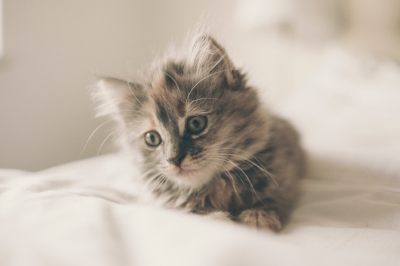
Q: I just adopted a new cat, but I have no idea what to do after I bring her home! Where do I start?
A: Congratulations on your new furry friend! Adopting a new cat or dog (or any new pet) is a very exciting time, but can also be stressful, between trying to decide on the best cat litter or dog food, and making sure your new pet fits into your home and is happy.
The first thing you should do upon (or preferably before) bringing home your new cat or dog is to pet-proof your home. Animals see things from a different vantage point than we do, because they are so low to the ground, and they tend to explore thing with their faces or mouths. It is best to secure anything that could be toxic, like paint or cleaning products, with tight-fitting lids or in cabinets that can’t easily be opened (my cat can open any drawer she wants to!). With a puppy or dog especially, it is important to be cognizant of what toys or objects you have lying out in the open. A dog or puppy can and will swallow random socks, small toys, bones, or other objects that can require emergency surgery to remove them. Finally, you’ll have to read up on what plants may be toxic to your new pet, in case you have them growing around your house or are fond of bouquets. Lilies, for example, are very toxic to cats.
Once you come home with your new friend, you’ll quickly realize that you need a few basic supplies, including bedding, food bowls, litter boxes for cats, and collars and leashes for dogs. All animals should be microchipped before you bring them home (and make sure you register your microchip! It doesn’t help you if it isn’t registered to your number or address). You’ll also want to pick up a carrier for cats or small dogs. If you intend to be flying a lot with your pet, check airline regulations to make sure you are buying a pet carrier that is in line with most major airline requirements. Toys are very important, because they help build a bond between you and your pet, and they provide essential mental stimulation for them, both when you are around and when you are gone. Select a few different types of toys at the beginning to see what your pet will like. Make sure they are good quality toys that cannot be easily ripped apart and swallowed by a curious puppy. We all know cats love string, and that’s okay, but make sure to watch kitty when she’s playing with the string; cats often swallow strings, which can cause a deadly obstruction of their intestines. Finally, don’t be offended if your dog or cat prefers your bed or couch to the pet bedding you just spent $30 on. Sometimes you just can’t win!
Diet is very important, especially for growing kittens and puppies. Be sure to select a diet that provides the full spectrum of necessary nutrients. Cats and dogs have different nutritional requirements from each other (and from humans), so feeding them human food, or feeding cats dog food, is not going to be healthy for them. Treats should be no more than 10% of your pet’s daily intake. We love to spoil our pets with food, especially because they look at us with those big soulful eyes. However, it is important to realize that you are the guardian of your pet. Only you can make the best choices for their health. Pet obesity is a growing issue, and just as in humans, can cause many problems for your pet down the line. To avoid pet obesity, follow the feeding guidelines as suggested on the back of your food bag, and try to avoid feeding table scraps and human food. There are also a number of human food items which are toxic to cats and dogs, including onions, garlic, raisins, grapes, and chocolate.
Try to find resources for pet owners in Facebook groups, dog park friends, or other social media outlets, so you can find other like-minded people and ask your questions. Additionally, it is vital to set up a relationship with a veterinarian and bring your pet for yearly checkups and vaccinations. When looking for a new veterinarian, try to find a practice close to your home with hours that work for your general work schedule. You should feel comfortable with the technicians, the doctors, the staff, and how they treat you and your pet. There is no relationship more important to your pet’s health than the owner-veterinarian-pet relationship, so if you do not feel that you mesh with your current practice, it is time to find a new one. The best thing for your pet is for you to feel comfortable asking any and all of your questions, no matter how embarrassing you might find them, to your veterinarian.
When you leave with your pet, you may have been provided with information on preventative care. This is our best first line of defense against any diseases that could seriously affect your pet. Preventative care includes keeping up with your yearly vaccinations and keeping up with heartworm, flea, and tick prevention. These medications can be easily purchased from your veterinarian. It only takes one mosquito bite to infect a dog or cat with heartworm disease, or one tick bite to infect a dog with Lyme’s disease. The easy, monthly preventative medications we have will save you and your pet a lot of heartache in the future.